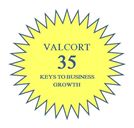An Earful of Change
Valcort 35 Keys to Business Growth: #6 When you talk with your customer, listen carefully, capturing their comments and any information that helps you understand their buying habits and unmet needs.
“WHY won’t you JUST LISTEN TO ME!” she said in a tense, high pitched voice.
And with that outburst from the famous Patient F in 1965, psychologist Heinz Kohut opened the vault of change management.
Kohut, along with his colleague Henri Maslow, was on a quest to identify the hot buttons for change. What must be done to get someone’s behavior to change?
Maslow, of course, came up with his Hierarchy of Needs, but legend has it he recognized that his approach was short-sighted, and did not create internally-driven, behavioral change. Kohut opened the door with his interaction with the now famous 25 year-old Miss F and the light bulb went on.
Let’s face it. If you’re in business, you’re in the business of change. Changing a prospect into a customer. Convincing bankers to change their opinion and setting your checkbook free. Changing the performance of your vendors. Changing the patterns and behaviors of an employee from doing X to doing Y.
The fact is that we are all involved in driving change. Every day.
Miss F’s famous outburst opened the path to Kohut establishing “self-psychology” – the idea that people change because they WANT to change, not because they are TOLD to change. Prior to Kohut, Freudian psychologists believed that a respected leader needed to simply prescribe behaviors forcefully and people would then just do it. It was that simple. And hopefully a good attitude would come along with it.
Sound familiar?
Business leaders, sales leaders, marketers, managers, and customer service reps too often believe that if we just tell people what to do, they’ll do it and change and have a good attitude about it. That won’t work.
When leaders do this, relationships become transactional, forcing compliance or driving a purchase and not building a trust-based relationship. This approach might help you hit a sales quota, but selling without empathy and trust creates a transaction, not a purpose-focused solution, a long relationship or a raving fan-advocate. In this kind of transaction creating engagement is about me, not about them. Trust breaks down. An engagement becomes a transaction, not a solution.
Kohut theorized that listening to a customer, employee, vendor, or partner recognizes their power to choose. When we listen, we respect them. We can empathize and with that empathy comes the opportunity to share a solution.
This requires a commitment to develop one of the cheapest and single most important strategic skills in your organization — your people’s ability to listen well. To hear. To understand.
The truth is that every person in your business sphere has unmet needs that frustrate them and drive them crazy.
The path to creating change is listening, capturing their thoughts and acknowledging their frustration. When the person you’re trying to engage sees that you understand, and empathize, then they’ll trust you as their advocate. They’ll open the door for a real, workable solution. When you offer a meaningful, relevant and valuable solution, it’s not a transaction, it’s a transformation. You have a customer for life.
The sixth Valcort key to business growth is listening to your customers, capturing their frustration to gain insight and understanding into their unmet needs and what you can do to help solve them. This is the essence of trust and a positive, rewarding, personal relationship. It’s also the key to sustainable growth.
Relationships built on these principles last.
Let’s look at a classic example of poor engagement. Take something as simple as leaving a phone message.
- Lame phone message #1: “Hey, Bob, just calling to check in and see how it’s going. Hey, give me a call sometime, let’s talk!”
- Lame phone message #2: “So how’s it goin’? What’s new? Haven’t talked in a while, is Jeff still around? Got a question for you. Give me a call…”
Ever wonder why someone won’t return your call or email? Its pretty simple – you bring no value.
These are lame icebreakers for the ages and are easy to fall into. While they are used every day by well meaning marketing professionals, customer service reps and researchers they’re just plain lame and create practically zero engagement.
I catch myself using them when I don’t have something more substantive to say. No wonder that customers won’t return a call like that!
Here is the critical truth: If you’re not helping your customer solve a problem, you’re wasting their time. You’re not bringing any significant value to your customer.
So the question is how do you bring value to your customer?
Listen, consider and respond. Usually, bringing value to a customer can’t be done well on the fly in an impromptu phone call or check up. Creating value takes listening, planning and a forming meaningful response to what you’ve heard.
Doing this consistently, and you’ll earn a reputation as a trustworthy advisor. In fact, your customers will call YOU when they’re “pulling-their-hair-out-crazy” to ask for your advice!
Too often we have conversations with our customers, employees, vendors or stakeholders and lose focus. We forget that the reason for our relationship is to help them solve their problems. If you don’t understand their frustrations, they won’t trust you to offer a valuable solution.
When engaged in a conversation, ask yourself: “what value am I bringing to this person right now?” Asking that simple question can help you bring focus to a conversation and change the quality, trust-level, and depth of your relationship.
You can simply and easily build a powerful, trust-based relationship. Start by listening.
__________________
The Valcort 35 Keys to Business Growth Over many years and hundreds of client relationships and strategic marketing opportunities, we have established the Valcort 35 Keys to Business Growth, best practices that build trust, align values with products and practices, and create organic growth. We are exploring these 35 practices, one at a time, on these pages. Find them all, as they’re introduced, here.
Tags: change management, Kohut, listening, Valcort, Valcort 35 Keys to Business Growth






